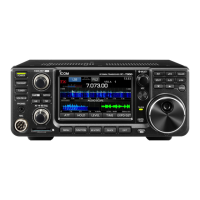3
BASIC OPERATION
3-2
When rst applying power
Before turning ON your transceiver for the rst time,
make sure all of the following are correctly connected.
• DC power cable
• Antenna
• Grounding wire
• Microphone*
* Different devices may be used, depending on the
operating mode.
If all listed above are correctly connected, set
(inner/outer) to the positions described
below.
TIP: When you turn OFF the transceiver, it memorizes
the current settings. Therefore, when you turn ON the
transceiver again, the it restarts with the same settings.
z To turn ON the transceiver, push
.
z To turn OFF the transceiver, hold down
for
2 seconds until “POWER OFF...” is displayed.
Turning power ON or OFF
Rotate
(inner) to adjust the volume level.
Adjusting the volume level
12 oʼclock position (outer)
Maximum counterclockwise (inner)
About the VFO and Memory modes
Using the VFO mode
VFO mode
You can set the desired frequency by rotating
.
Memory mode
You can enter contents into the memory channels in
the MEMORY list.
Selecting the VFO mode or Memory mode
Push
to select the VFO or Memory mode.
The IC-7300 has 2 Variable Frequency Oscillators
(VFO), “A” and “B.” Having 2 VFOs is convenient to
quickly select 2 frequencies, or for split frequency
operation (p. 4-13). You can use either of the VFOs to
operate on a frequency and mode.
D Selecting VFO A or VFO B
Push
to select the VFO A or VFO B.
D Equalizing VFO A and VFO B
You can set the displayed VFO’s frequency and mode
to the VFO that is not displayed.
Hold down
until 2 short beeps sound.
VFO mode
(Example: VFO A)
Memory mode
(Example: Memory channel 1)
VFO A VFO B

